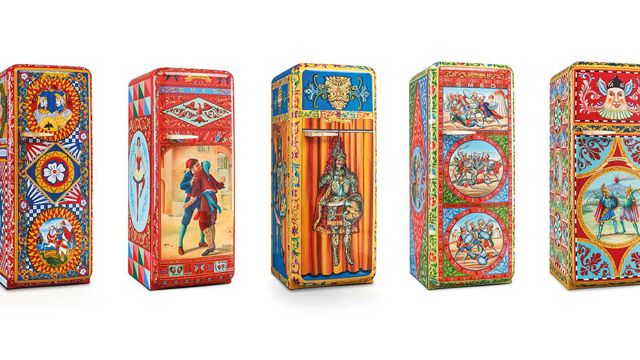
Smeg: crafted under an Italian sky
Ollie Lloyd heads to Smeg HQ in Emilia-Romagna and discovers a company obsessed with design, the arts and a quintessentially Italian way of working.
Smeg: crafted under an Italian sky
Ollie Lloyd heads to Smeg HQ in Emilia-Romagna and discovers a company obsessed with design, the arts and a quintessentially Italian way of working.
When you think of great Italian design brands you think of Ferrari, Vespa, Piaggio, Prada, Dolce and Gabbana or Maserati – to name just a few. But one brand you might not think of as quintessentially Italian is Smeg, despite its incredible heritage. Its most recognisable product is of course the curvaceous fridge with its striking colours and 1950s shape that adorns many a kitchen. Yet Smeg, which stands for Smalterie Metallurgiche Emiliane Guastalla (or the Guastalla Emilia Enamel Works), was originally set up as an enamelling business in 1948 and is truly inspired by Italy and the idea of being ‘Made in Italy’. The head office for Smeg is in Emilia-Romagna, a region well known for its food – specifically Prosciutto di Parma, Balsamico di Modena vinegar and Parmigiano Reggiano – and being the birthplace of Ferrari.
Approaching Smeg's headquarters under the erratic leadership of Apple maps, I am sure I am in the wrong location. There is no sign of a huge company; instead, it feels like I should be looking for a holiday villa. Finally, I turn a corner and am greeted by the most elegant of security gates, lines of trees and manicured lawns that cleverly shield the building. The headquarters were designed by Guido Canali, an architect who restored the Duomo in Milan and the National Gallery in Parma. The building is a low slung modernist beauty which is nestled within the landscape and is surrounded by shallow pools of water. Inside is a huge atrium of polished concrete and walls adorned with large contemporary paintings. It is more akin to a modern art gallery in New York or London than a white goods company headquarters located in rural Italy.
Vittorio Bertazzoni is the company's CEO, grandson of the original founder Vittorio Bertazzoni who originally set up the company. The family started making cookers in the 1900s, and even showed one of their products at the World Expo in Milan in 1906. However, it was under the brand Smeg in the 1950s that they made one of the first gas cookers and quickly capitalised on the post-war boom in domestic appliances. The 1960s was a golden age for consumerism when everyone wanted new products and the market was buzzing with portable TVs, fridges, upright vacuum cleaners, blenders and entertainment systems.
However, by the 1970s the market was saturated and everyone was producing things that looked more or less the same. Rather than merging with other similar businesses in the pursuit of scale, Vittorio’s father decided to innovate and embrace design. He started to work with architects to further differentiate his products and strove to create things that were both beautiful and high tech. Smeg's ethos, then as it is now, is one of extraordinary collaborations, working with architects and design studios like Guido Canali (who created Smeg’s HQ), Renzo Piano (who designed The Shard in London), Marc Newson and Mario Bellini. They worked together to produce stunning, tactile and precise products. It's a testament that some of the 'classic' designs that Smeg created with Guido Canali are still produced today – this is design that doesn’t drop out of fashion.
The people at Smeg see the objects they create as things of beauty, believing consumers want beauty in their lives. Vittorio places this within a very Italian context and sees beauty as being something integral to Italian daily life; particularly cooking. He believes the kitchen is at the heart of the home, and Smeg's products celebrate this – in its ovens alone, integrated pizza stones, specific temperature settings for proving bread and built-in rotisseries show how the company makes entertaining that much more beautiful, enjoyable and easy. When I wandered the streets of Bologna later on a balmy evening and found a late night open air screening in the Piazza Maggiore, with crowds of people enjoying good food in great company, it felt hard to disagree with Vittorio's belief that in Italy, cuisine is an integral part of the country's culture.
Ollie Lloyd
Art meets design
The interesting thing is that when I dug deeper to explore the Smeg aesthetic, I was struck by the sheer breadth of what they are doing. ‘There are two souls in the business,’ says Vittorio. ‘One that is born of the 1950s and the other that is inspired by contemporary architectural collaborations.’ The 1950s-inspired products are the kind of objects that one easily falls in love with. They are curvaceous, come in a variety of bright colours and exude a sense of happiness. The 1950s range now goes beyond fridges and large appliances and includes small appliances such as kettles, toasters, stand mixers and blenders. The stand mixer in particular looks set to be a design classic and reminds me of the front wings of a 1950s Porsche. The architectural range, while being more modern and sleek than the 1950s styled products, still has the elegant lightness of touch and ease of use that Smeg has become known for. A new product that caught my eye was a gas hob from the company's new Dolce Stil Novo range where the usual metallic rings around the gas outlets had been poetically replaced by little birds, seemingly pecking invisible seeds. For a privately held company, the sheer range of what they do is impressive. They have everything from dishwashers to range cookers and built-in ovens, small appliances to washing machines, wine coolers to coffee machines. One of the things that makes Smeg standout is the huge range of options and colours – offering consumers real choice and coordination across their appliances. Vittorio says their catalogue offers one of the biggest selections of products in the industry. After all, who else can say they have a denim, blackboard or Mondrian fridge for sale?
The desire to collaborate and create extraordinary products is stronger than ever. Perhaps the most ambitious project in the company’s history is a recent collaboration with Dolce & Gabbana, another brand that shares the 'Made in Italy' values of Smeg. Vittorio had met Domenico Dolce informally a few times and started talking about doing a collaboration together. The idea they came up with is radical: create 100 Smeg fridges hand-painted by traditional Sicilian cart painters. It is a true celebration of the handmade and the industrially designed. The fridges are painted by Sicilian artists with traditional scenes and patterns: images of battling knights, kissing couples, scenes from famous folk tales, duels between key heroes in Sicily’s history and even the slaying of a dragon.

Made in Italy
The process to create these fridges is more an act of love than a business process. Panels are sent down to Sicily and the artists send ideas for the fridges to Dolce & Gabbana and Smeg. The teams work together to ensure that each one of these fridges are totally unique. ‘We are about tech, of course, but the added value with Smeg is beauty,’ says Vittorio. ‘Beauty is what we know best and so in a way this project explains our brand policy.’ Many brands engage with the arts via sponsorships of exhibitions and the odd commission, but this is a commitment on a different level.
‘Technology with style’ may be the tagline for the company, but this isn’t a business that’s driven by slogans. Smeg has the freedom to explore and test new ideas with a 'Why not?' attitude. Vittorio relates a story of working on a new line of fridges with Renzo Piano which I had admired while exploring the vast showroom at the entrance of the HQ. ‘I am talking to Renzo and he says, ‘I don't think we should put any Smeg logo on the fridge’,’ says Vittorio. Now for a brand to hear that is difficult, but Renzo argued that at home, children tend to use the fridge the most; a demographic that’s bombarded with brands in every aspect of their life. So why not have a fridge with no logo? He convinces Vittorio that everyone will know it's Smeg because it is so beautiful and so, ‘we are brave enough to do it’.
Since we launched Great Italian Chefs, I have been struck by the fact that chefs are challenging the traditions (some might even argue the very foundations) of Italy. When I met Massimo Bottura a year ago, he spoke to me of a desire to smash the pantheon of Italian tradition. It is not that chefs like Massimo or CEOs like Vittorio have an issue with the past, it is that they want to make it more vibrant, more relevant to today’s consumers in Italy and beyond. Italy has rich and glorious traditions, both culinary and artistic, that can be built upon. It takes a bold person to embrace the future. It takes an even bolder one to embrace the future with an eye to the past and in collaboration with others. Vittorio has tremendous respect for the company that his forefathers crafted and for the innovative steps they took, in moving beyond mere manufacturing, rejecting the march towards conformity through mergers and in embracing others’ visions in bold collaborations. In Vittorio’s vision of the future, the thing that makes ‘Made in Italy’ special is not merely that an item is actually manufactured in Italy, but that it is imagined and crafted under an Italian sky.
Ollie Lloyd


